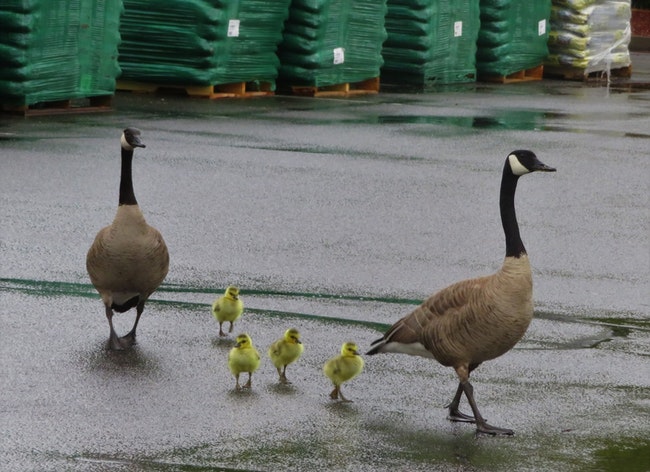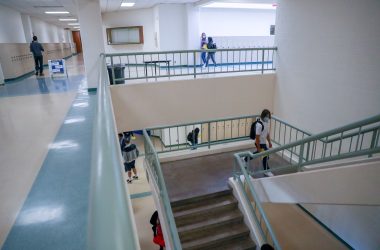
A family of Canada geese in the Lowe’s parking lot in Salem (Harry Fuller/Special to Salem Reporter)
The common name “Canada” goose connects directly to the Latin scientific binomial Branta canadensis. Both are geographically inaccurate like Nashville warbler, Philadelphia vireo or California quail (found in six states and three nations). The Canada goose breeds across North America, Alaska to Maine and Nova Scotia. Some winter in locales from California to Mexico to Florida.
In fall and winter Canada geese of several subspecies, and their little cousin the Cackling geese, arrive in the Willamette Valley. Many remain, then head back north in spring. Our national wildlife refuges may host tens of thousands at one time in season—from Tualatin River in the north, to Baskett Slough, Ankeny and south to Finley. This cold weather population has been gathering in this valley for centuries.
But something different is happening around us: the large, pale-chested Canada geese we now see on fields, marshes, golf courses and park lawns, ones that breed here, the ones are that trying to raise goslings right now. That’s fairly new. The 1940 book “Birds of Oregon” stated clearly that the Canada Geese nested only east of the Cascades.
Finding out how and when and why our species introduced these resident geese here is difficult. Nobody publicly admits credit or blame for today’s resident geese. I found one essay on a program dubbed “Mother Goose” from the late 1960s. That was introducing Canada geese to the Columbia Gorge and points west.
The 2006 “Birds of Oregon” says: “Numerous poorly documented and undocumented releases of Canada geese have been made in the western states from privately owned captive flocks (former decoy flocks) … Some of these mixed-origin birds became semi-wild ‘park’ geese, which, when they became a nuisance, were ‘managed’ by transplanting them to other locales. Many resident populations in w. Oregon originated through transplant operations.”
I spoke with Brandon Reishus, Migratory Game Bird Coordinator for Oregon Department of Fish and Wildlife. Their records show goose nesting counts being done in Jackson County in the late 1960s, then similar counts in Umpqua watershed around 1980. No Willamette records. He points out the geese may have spread without much direct help. Post-World War II agricultural practices have spread goose fodder across the valley. Dams on the upper Columbia now prevent spring floods making islands (like Sauvie) perfect for spring-nesting geese.
Resident geese face some threat from avian flu. Infected geese have been found in Salem. Reishus says this year’s flu variant so far has not often killed wild birds. In the future it will likely be our species that determines the fate of Canada geese. Foster City, California is considering a goose slaughter—seems their excrement (largely digested lawn grass) is unacceptable.
For information about upcoming Salem Audubon programs and activities, see www.salemaudubon.org, or Salem Audubon’s Facebook page.
Harry Fuller is an Oregon birder and natural history author of “Freeway Birding.” He is a member of the Salem Audubon Society. Contact him at [email protected] or atowhee.blog. His “Some Fascinating Things About Birds” column appears regularly in Salem Reporter.
JUST THE FACTS, FOR SALEM – We report on your community with care and depth, fairness and accuracy. Get local news that matters to you. Subscribe to Salem Reporter starting at $5 a month. Click I want to subscribe!









